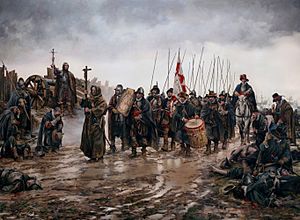Battle of Empel facts for kids
Quick facts for kids Miracle of Empel |
|||||||
|---|---|---|---|---|---|---|---|
| Part of the Eighty Years' War | |||||||
 El milagro de Empel, by Augusto Ferrer-Dalmau (2015). |
|||||||
|
|||||||
| Belligerents | |||||||
| Commanders and leaders | |||||||
|
|||||||
| Strength | |||||||
| 100-200 ships, 30,000 men | 4,000-6,000 men | ||||||
| Casualties and losses | |||||||
| all ships captured and burned | few | ||||||
The Miracle of Empel (called Milagro de Empel in Spanish) was an amazing and unexpected victory for the Spanish army. It happened on December 8, 1585, near a place called Empel in the Netherlands. This event was part of the Eighty Years' War, a long fight where the Dutch wanted to be free from Spanish rule. In this battle, a small group of Spanish soldiers, who were completely surrounded, managed to win against a much larger enemy force.
Contents
The Miracle of Empel: A Surprising Victory
What Happened Before the Battle?
In 1585, the Eighty Years' War was still going strong. This was a time when the Dutch people were fighting for their independence from Spain. Cities often changed hands between the Spanish and the Dutch. For example, the city of Antwerp was captured by the Spanish commander, Prince of Parma, in August 1585.
The Dutch were looking for help from other countries. France was having its own problems, so they turned to England. England's Queen Elizabeth I was happy to help, especially if it meant bothering Spain's King Philip II. So, in August 1585, England agreed to send 6,000 soldiers to help the Dutch.
The young Maurice, Prince of Orange, who had just become a leader in Holland, faced a very tough challenge.
How the Battle Began
After fighting throughout 1585, the Spanish commander, Prince of Parma, decided his troops should settle down for the winter. About 3,000 to 4,000 Spanish soldiers, known as Tercios (a type of Spanish infantry unit), were sent to an island called Bommelerwaard. Their leader was Francisco Arias de Bobadilla. They expected to find enough food and supplies there for the winter.
However, the island was empty! All the farmers and their animals had left. This left the Spanish soldiers hungry and without supplies. To make things worse, a Dutch commander named Philip of Hohenlohe-Neuenstein arrived with a huge army and 100 ships.
The Dutch leader offered the Spanish a chance to surrender honorably. But the Spanish soldiers refused, saying: "Spanish soldiers prefer death to dishonor. We will talk about surrender after death."
The Spanish Trapped
To trap the Spanish, the Dutch commander, Philip of Hohenlohe-Neuenstein, broke the dikes (walls that hold back water) on Bommelerwaard. This flooded the land, forcing the Spanish soldiers to move to higher ground around Empel. From there, they couldn't reach their main army because the land was underwater and the Dutch fleet blocked the rivers. The Dutch also attacked them with cannons from a fort across the river. The Spanish were in a terrible situation, surrounded and starving.
The Miracle Happens
While the Spanish were trapped, one soldier was digging a trench around a church. He supposedly said, "This is more likely to be my grave than a trench." As he dug, he found a painting of Mary of the Immaculate Conception. Their commander, Bobadilla, saw this as a sign from God. He had the painting put up next to the Spanish flag for everyone to see and pray to.
That very night, something amazing happened. The temperature suddenly dropped a lot, and the shallow floodwaters around them began to freeze solid! This created a path for the Spanish troops. They were able to attack the Dutch ships and burn them. The next day, they charged and captured the Dutch fort along the river.
Admiral Hohenlohe-Neuenstein, the Dutch commander, was shocked. He reportedly said: "In my opinion, it seems that God is Spanish to work so great a miracle [for them]."
That same day, Mary of the Immaculate Conception was declared the special protector of the Spanish Tercios (infantry units) in Flanders and Italy.
Mary of the Immaculate Conception
A Special Patroness
On December 8, 1854, a very important religious event happened. Pope Pius IX officially declared the "dogma" (a core belief) of the Immaculate Conception of the Blessed Virgin Mary. This means the belief that Mary was born without sin was made an official teaching of the Catholic Church.
Later, in 1892, Maria Cristina of Austria, who was the Queen Regent of Spain at the time, made Mary of the Immaculate Conception the patroness (a special protector) of the entire Spanish Infantry. This shows how important the "Miracle of Empel" became to the Spanish army and their faith.
Images for kids
See also
 In Spanish: Milagro de Empel para niños
In Spanish: Milagro de Empel para niños



